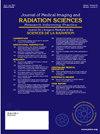Simultaneous Estimation of Bone Morphology and Fat Fraction Using General-purpose Magnetic Resonance Imaging
IF 1.3
Q3 RADIOLOGY, NUCLEAR MEDICINE & MEDICAL IMAGING
Journal of Medical Imaging and Radiation Sciences
Pub Date : 2024-10-01
DOI:10.1016/j.jmir.2024.101522
引用次数: 0
Abstract
Background / Purpose
Intravertebral fat degeneration may be a potential risk factor for bone fractures. Previously, measurements of vertebral morphological changes and fat fraction have been performed separately. However, separate measurements can lead to positioning errors, and with regard to X-ray examinations, an added factor of radiation exposure also exists. Our developed method allows for the simultaneous evaluation of bone morphology and fat fraction using magnetic resonance imaging (MRI), addressing the concerns mentioned above.
Methods
All examinations were performed on a 1.5 T MRI system. To obtain a bone image, multi-echo images with in-phase (i.e., echo time [TE], comprising 4 TE, ranged from 4.6–18.4 ms) were acquired. We generated a bone image by applying an inversion process to the sum of the four images. Additionally, by setting the initial TE of the multi-echo image to the opposed phase (i.e., TE, 2.3 ms), the fat fraction was calculated on a pixel-by-pixel basis. Furthermore, a field map was used to correct the inhomogeneity of the magnetic field within the in-plane using MATLAB 2023b.
Results
Images that enabled the evaluation of bone morphology similar to X-ray computed tomography were obtained from MRI. Using the in-phase images from multi-echo MRI also made it possible to evaluate trabecular bone. Additionally, opposed-phase images were used to calculate fat fraction images. By incorporating the field map into the analysis, obtaining a more accurate image of the fat fraction was possible without magnetic field inhomogeneity.
Conclusion
This method can be completed in a single imaging session, with minimal burden on the participant and no positional displacement, in a clinically useful manner.
利用通用磁共振成像技术同时估算骨形态和脂肪比例
背景/目的椎体脂肪变性可能是导致骨折的潜在风险因素。以前,椎体形态变化和脂肪率的测量是分开进行的。然而,单独测量可能会导致定位误差,而且在 X 光检查中还会增加辐射暴露的因素。我们开发的方法可利用磁共振成像(MRI)同时评估骨形态和脂肪率,解决了上述问题。为了获得骨骼图像,我们采集了同相位多回波图像(即回波时间[TE],包括 4 个 TE,范围为 4.6-18.4 毫秒)。我们对四幅图像的总和进行反转处理,生成骨图像。此外,通过将多回波图像的初始 TE 设置为对置相位(即 TE,2.3 毫秒),逐像素计算脂肪分数。此外,还使用 MATLAB 2023b 对平面内磁场的不均匀性进行了场图校正。使用多回波核磁共振成像的同相图像还可以评估骨小梁。此外,对相图像还可用于计算脂肪分数图像。通过将磁场图纳入分析,可以在没有磁场不均匀性的情况下获得更精确的脂肪分数图像。
本文章由计算机程序翻译,如有差异,请以英文原文为准。
求助全文
约1分钟内获得全文
求助全文
来源期刊

Journal of Medical Imaging and Radiation Sciences
RADIOLOGY, NUCLEAR MEDICINE & MEDICAL IMAGING-
CiteScore
2.30
自引率
11.10%
发文量
231
审稿时长
53 days
期刊介绍:
Journal of Medical Imaging and Radiation Sciences is the official peer-reviewed journal of the Canadian Association of Medical Radiation Technologists. This journal is published four times a year and is circulated to approximately 11,000 medical radiation technologists, libraries and radiology departments throughout Canada, the United States and overseas. The Journal publishes articles on recent research, new technology and techniques, professional practices, technologists viewpoints as well as relevant book reviews.
 求助内容:
求助内容: 应助结果提醒方式:
应助结果提醒方式:


